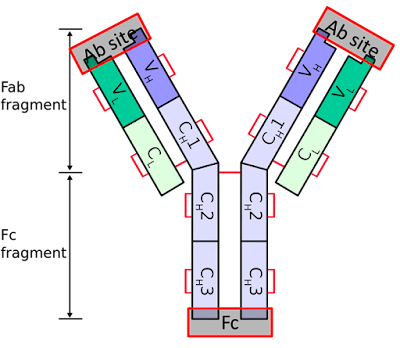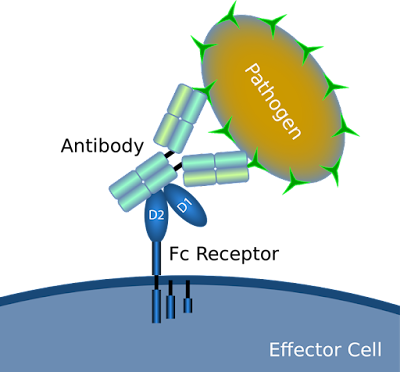Structure of IgG: H2L2; consists of 2 heavy chain and 2 light chains joined by disulphide bond
- Heavy Chain: ϒ for IgG (Gamma; that’s why IgG)
- Antigen binding sites:2 in the Fab fragment made up of both H chain and L chain
- MW: ~150,000 D
Which is the most abundant antibody?
% in serum: ~80% and most abundant antibody
Function:
Which antibody can cross placenta?
The only antibody that can cross placenta is IgG. IgG is the
only maternal immunoglobulin that can cross the placenta and provide natural
passive immunity to the fetus.
IgG can Fix complement:
How IgG fixes complement?
Fc region of IgG bound
infected cells can activate complement proteins (set of serum proteins involved
in first line of defense) that works in cascade activating many other complement
proteins finally causing destruction of infected cells by enhancing phagocytosis
by phagocytes or by the formation of membrane attacking complex (MAC) causing
the destruction of infected cell (See the figure).
Fc region of IgG Binds to Phagocytes or effector cells like
cytotoxic T cells causing destruction of infected cell
How many subclasses for IgG?
- 4 subclasses IgG1, IgG2, IgG3 and IgG4 in the order of their abundance in serum
- IgG2 is directed against encapsulated bacteria.
- IgG is the predominant antibody in secondary immune response along with IgM.
- IgG mediates Type II hypersensitivity
- Neutralization (IgG covers toxins of pathogens by close binding, thereby causes neutralization)
- Agglutination (causes clumping of pathogens like bacteria which are later cleared out by phagocytes)
- complement activation
- opsonization (binding of IgG to infected cells acts as a signal for phagocytes, thus enhancing the phagocytosis by phagocytes)
- Ab dependent cell mediated cytotoxicity (Cytotoxic T cells can directly interact with the Fc region of IgG bound infected cell and can cause destruction of that infected cells).




